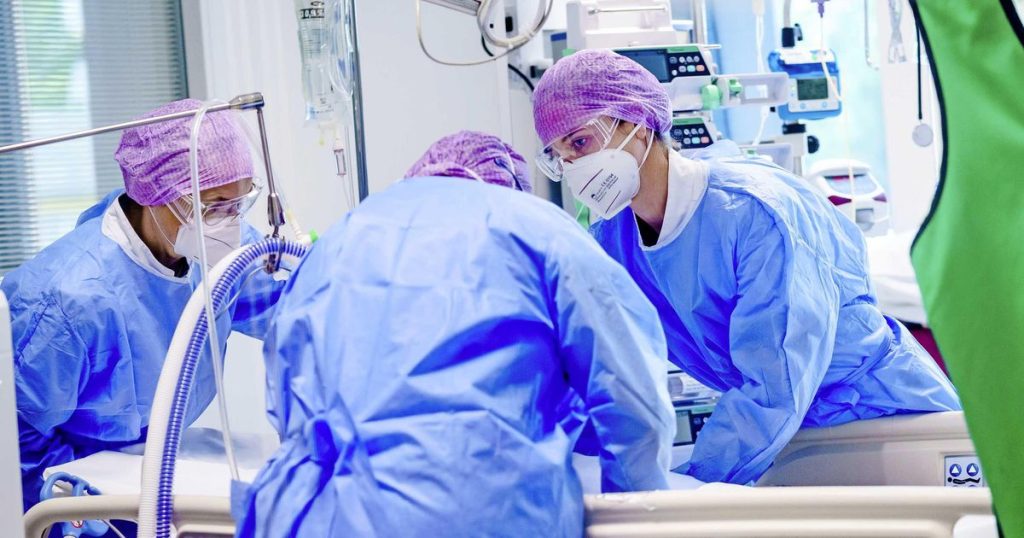The number of positive tests is increasing in every age group. The virus was found last week in 1,434 children between the ages of 5 and 9. This is 55 percent more than the previous week. Among people aged 45 to 49, the number of new cases rose by about 62 percent. An increase of about 75 percent was observed between the 1970s and about 80 percent among those over the age of 90, but these are still fairly small numbers.
The number of reproductions, which indicates how quickly the coronavirus is spreading, is also increasing. It now stands at 1.12. This is the highest level since July 8. A number of 1.12 means that one hundred people infected with corona infect an average of 112 others. They then transmitted the virus to 125 people, who in turn infect 140 people.
Hospitals
The number of corona patients in Dutch hospitals rose to 512 on Tuesday, 15 more than on Monday, according to the National Coordination Center for the spread of patients (LCPS). This is the highest number since September 23.
In nursing wards, the number of Covid-19 patients, the disease caused by the coronavirus, has risen from 15 to 374. There are 138 patients with corona in intensive care units, as on Monday.
In the past 24 hours, 59 new Corona patients entered the nursing wards, but because people were also allowed to leave the hospital, the number of occupied beds increased by 15. 10 people were brought to the intensive care units.
The first and second wave
Occupancy in the hospital remains relatively low compared to previous periods. Between October 2020 and May 2021, between 100 and 300 patients were brought in continuously per day, according to the coronavirus dashboard. Then the hospital occupancy for months was between one thousand and two thousand. At the first peak, nearly five hundred people were admitted to the peak and 3,000 patients were hospitalized at any one time.
:quality(50)/cdn-kiosk-api.telegraaf.nl/ae871b46-2b59-11ec-9ff7-0217670beecd.jpg)
Highest daily number since July 31
Between Monday morning and Tuesday morning, there were 2,914 new cases of coronavirus. This is the highest number in a single day since July 31.
In the past seven days, the National Institute of Public Health and the Environment (RIVM) has recorded 17,832 positive tests, with an average of 2,550 tests per day. This average is rising for the twelfth consecutive day.
Converted into population, the Netherlands counted 16.7 positive tests per 100,000 inhabitants in the past day. It is the 100th day in a row that the country is above what is called the signal value. This is the level at which government alarm bells ring. This happens with at least 7 positive tests for every 100,000 Dutch people, which is about 1,222 positive. The last time the Netherlands stayed below that border was on the 4th of July.
Most infections are at school and at work
Relatively many people have contracted coronavirus at school or at work. These have become important ‘places of infection’, according to weekly figures from the National Institute of Public Health and the Environment on the state of the coronavirus outbreak.
More than half of the new cases with known source were infected at home, by a co-worker or family member. Visiting each other resulted in 14 percent of cases.
In about 14 percent of people, the infection can be traced back to a school or childcare facility. This is similar to last week. Of all the people who tested positive since the beginning of August, the school or nursery school was the source in 10 percent of cases.
After education, the work situation follows: about 8 percent of the people there became infected. This percentage is similar to last week, but higher than the level since early August. Parties such as birthdays, drinks and weddings have caused more corona infection than previous weeks.
Lowest number of corona shots
In the past week, about 103,000 people received their first or second shot of the coronavirus vaccine. This is the lowest number of injections per week since the first period of the vaccination campaign in January, according to the latest vaccination figures from the National Institute of Public Health and the Environment (RIVM).
More than 43,000 people received the first blow of Corona last week. This is also a relatively low number: in the previous weeks, more than 65,000 people in a week were given the first dose of the corona vaccine.

“Total coffee specialist. Hardcore reader. Incurable music scholar. Web guru. Freelance troublemaker. Problem solver. Travel trailblazer.”







More Stories
GALA lacks a chapter on e-health
Weird beer can taste really good.
Planets contain much more water than previously thought